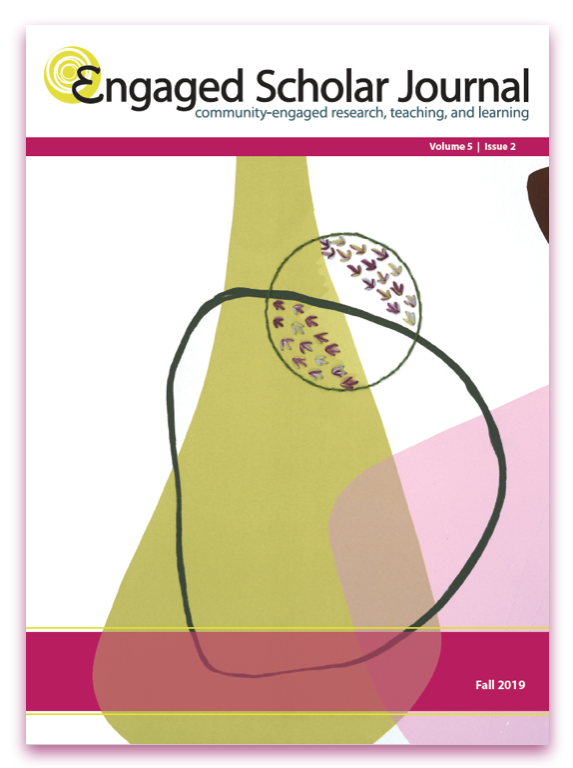Community-Based Intersectionality: The Changing Public Services Project
DOI:
https://doi.org/10.15402/esj.v5i3.61618Abstract
The paper reflects on a changing public service project regarding women and intersectional analysis in Halifax, Canada. The project sought to facilitate collective mobilizations to challenge austerity and to imagine public services that meet the needs of the citizens who use them, and the workers that provide them. We provide an overview of the project, and then explore our attempt at adapting “multistrand” intersectional policy analysis (Hankivsky & Cormier, 2011) to a community-based context. In considering the challenges and opportunities associated with this work, the paper concludes that the changing public service project created space for an innovative approach to community-based research that can guide both participatory policy analysis and collective action.
References
_9780662450870_e.pdf
Canada. Clerk of the Privy Council. (2014). Public Service Renewal. Oct. 2.
Retrieved from http://www.clerk.gc.ca/eng/feature.asp?pageId=73
Canada. Clerk of the Privy Council. 2012. Moving Ahead: Public Service Renewal in a Time of Change. Prime Minister’s Advisory Council on the Public Service. Sixth Report to the Prime Minister. March. Retrieved from http://www.clerk.gc.ca/local_grfx/docs/pmacccpm/6-2012-eng.pdf
Canada. Public Service Commission. 2008. The 100 years of the Public Service Commission of Canada 1908-2008. July. Retrieved from http://www.psc-cfp.gc.ca/abt- aps/tpschcfp/hist-eng.pdf
Canadian Research Institute for the Advancement of Women (CRIAW). 2014. Changing Public Services. Ottawa. Retrieved from http://www.criaw-icref.ca/en/page/changing-public- services
___. (2006). Intersectional Feminist Frameworks. Ottawa. Retrieved from
http://criawicref.ca/sites/criaw/files/IFFs%20Primer.pdf
Cho, Sumi, Kimberlé Williams Crenshaw, and Leslie McCall. 2013. Toward a Field of Intersectionality Studies: Theory, Applications, and Praxis. Signs, 38(4, Summer), pp. 785-810.
Chun, Jennifer Jihye, George Lipsitz, and Young Shin. 2013. Intersectionality as a Social Movement Strategy: Asian Immigrant Women Advocates. Signs, 38(4, Summer), pp 917-940.
Clark, Natalie, Sarah Hunt, Georgia Jules, and Trevor Good. 2010. Ethical Dilemmas in Community- Based Research: Working with Vulnerable Youth in Rural Communities. Journal of Academic Ethics, 8(4), pp. 243-252.
Cohen, Marjorie Griffin and Jane Pulkingham. (Eds.). (2009). Public Policy for Women: The State, Income Security, and Labour Market Issues. Toronto: University of Toronto Press.
Dhamoon, Rita and Olena Hankivisky. 2011. Why the Theory and Practice of Intersectionality Matter to Health Research and Policy. In Olena Hankivksy (Ed.), Health Inequities in Canada: Intersectional Frameworks and Practices (p. 16-50). Vancouver: UBC Press.
Four Worlds Centre for Development Learning. (2000). The Community Story Framework: A Tool for Participatory Community Analysis. Cochrane, AB: Four Worlds Centre for Development Learning.
Gregory, Tara, Diane Betzen, Dina Elias-Rodas, Maaskelah Thomas, and Tara Augustin. 2008. Guiding Principles for Youth Civic Engagement. The Community Psychologist, 41(3/4), pp. 62-65.
Hankinvsky, Olena and Renée Cormier. 2011. Intersectionality and Public Policy: Some Lessons from Existing Models. Political Research Quarterly, 64(1), pp. 217-229.
Hankivsky, Olena et al. 2012. Intersectionality-Based Policy Analysis. In O. Hankivsky (Ed.), An Intersectionality-Based Policy Analysis Framework (p. 33-46). Vancouver: Institute for Intersectionality Research and Policy, Simon Fraser University. Retrieved from http://www.sfu.ca/iirp/documents/IBPA/IBPA_Framework_Complete
%20Collection_Hankivsky_2012.pdf
Institute of Public Administration of Canada (IPAC). 2013. An Armchair Discussion on Public Service Renewal. Nova Scotia Regional Group of the Institute of Public Administration of Canada (IPAC) and Nova Scotia Federal Council.
International Centre for Parliamentary Studies (ICPS). (2012). Public Sector Reform. Retrieved from http://www.parlicentre.org/Public_Sector_Reform.php
Ontario. Commission on the Reform of Ontario’s Public Services.
2012. Public Services for Ontarians: A Path to Sustainability and Excellence. Retrieved from http://www.fin.gov.on.ca/en/reformcommission/chapters/report.pdf
Parken, Alison and Hannah Young. 2007. Integrating the Promotion of Equality and Human Rights for All. Unpublished Report for Welsh Assembly Government and Equality and Human Rights Commission.
Professional Institute of the Public Service of Canada. n.d. The Big Chill: Silencing Public Interest Science, A Survey. Retrieved from http://www.pipsc.ca/portal/page/portal/website/issues/science/bigchill
Ross, Stephanie. 2008. Social Unionism and Membership Participation: What Role for Union Democracy? Studies in Political Economy, 81(Spring), pp. 129-157.
Smithson, Janet. 2000. Using and Analysing Focus Groups: Limitations and Possibilities. International Journal of Social Research Methodology, 3(2), pp. 103-119.
United Nations. United Nations Economic Commission for Africa (UNECA). 2010. Innovations And Best Practices in Public Sector Reforms: The Case of Civil Service in Ghana, Kenya, Nigeria and South Africa. December.
Voices-Voix. Silencing the Public Service, n.d. Retrieved from http://voices-
voix.ca/en/facts/attacks-on-the- public-service
Waddell, Steve. (2012). Global Finance as an Action Research Domain: Testing the Boundaries. Action Research, 10(1), pp. 40-60.
Downloads
Published
How to Cite
Issue
Section
License
Authors who publish with this journal agree to the following terms:
- Authors retain copyright and grant the journal right of first publication with the work simultaneously licensed under a Creative Commons Attribution License CC BY 4.0 that allows others to share the work with an acknowledgement of the work's authorship and initial publication in this journal.
- Authors are able to enter separate, additional contractual agreements for the non-exclusive distribution of the journal's published version of the work (e.g., post it to an institutional repository or publish it in a book), with an acknowledgement of its initial publication in this journal.
- Authors are permitted to post their work online (e.g., in an institutional repository or on their website) after the publication of their work in the Engaged Scholar Journal.
- Please note that while every opportunity will be taken to ensure author participation in the editing process, due to time constraints final copyediting changes may be made before publication to ensure APA adherence throughout all submissions.




